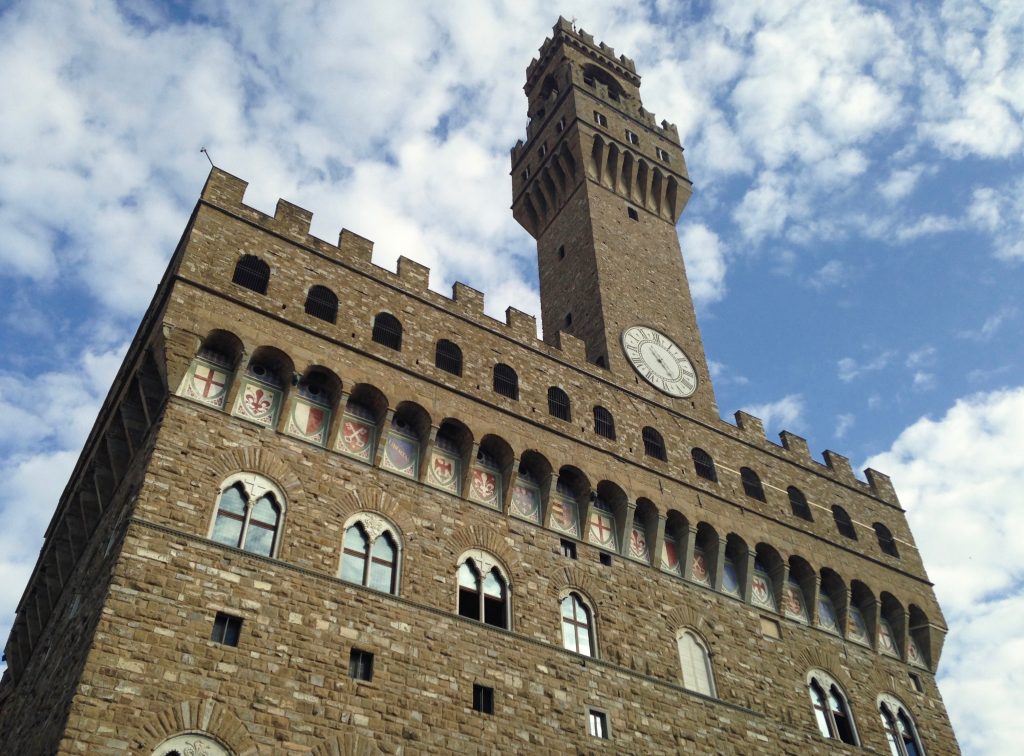The Palazzo Vecchio is one of the highlights in Piazza Signoria, and a symbol of Florence’s civic power. Today it hosts the town hall and a fascinating museum.
A visit to the Palazzo Vecchio is a must. Especially if you want to know more about the history of Florence. It has magnificent rooms decorated by Renaissance and Mannerist masters. There are informative guided tours that will help you better appreciate the Old Palace’s intricate history, and you can even climb the Arnolfo Tower.
The imposing Medieval building towering over Piazza Signoria was the seat of the Florentine government since 1314. It was refurbished completely by the Medici family, starting with Duke Cosimo I, who came to live here in 1540 before moving to the larger Palazzo Pitti. The opulence of the interior decorations was intended to mirror the power of the Medici, and artists such as Vasari and Michelangelo were employed to fill the rooms with grand works of art and lavish ornamentations.

Palazzo Vecchio’s highlights:
Salone dei Cinquecento (Hall of the Five Hundred) – The largest and most important of the rooms. This vast hall was built in 1494 to be used as meeting place for the Government (the Gran Consiglio had 1000 members that would meet in turn) during the brief Republic of Savonarola.
Later Cosimo I de’ Medici held court here, and it took Vasari and his school, in consultation with Michelangelo, two years to decorate it. The walls are covered in frescoes and the coffered painted ceiling was an architectural tour de force.
=> 7 Unmissable Museums in Florence
Everything in this room celebrates Cosimo I’s achievements and his military victories against the city’s eternal enemies Pisa and Siena. Cosimo I himself is depicted in a painting at the very centre of the ceiling, posing like a God. The Mannerist style is opulent and dramatic, with vibrant colours.
The sculpture ” The Genius of Victory” by Michelangelo couldn’t be more appropriate here, amongst all the celebratory art.

Sala dei Gigli, (Hall of the Lilies) – On the second floor you’ll find this elegant room adorned by Ghirlandaio’s frescoes (1482-5), with classical themes and a depiction of Florence. Donatello’s bronze statue “Judith and Holofernes” has a political meaning. Judith was the biblical heroin who saved her city by decapitating her enemy. This subject was common at that time because it represents the victory of good over evil, in the same way as David and Goliath. The lilies are there in honour of the King of France who was the protector of the Florentine Republic.
The adjoining Hall of the Maps is a fascinating sight, and the small study off the hall was once Machiavelli’s office.
The Palazzo Vecchio tours are highly recommended. Book the intriguing ‘Secret passages Tour‘ during which hidden rooms and secret staircases are revealed to visitors, including the Studiolo of Francesco I de’ Medici, who used to experiment with alchemy.
Arnolfo Tower – Climb the four hundred steps to the top of Florence’s highest tower and enjoy spectacular views.
=> Discover the Loggia dei Lanzi in Piazza Signoria

Did you know?
Leonardo da Vinci’s lost fresco – In 1503 Leonardo was commissioned to decorate one of the walls of the Salone dei Cinquecento with scenes from “The Battle of Anghiari“. He wanted to try a new technique and used oil paint, but unfortunately it didn’t adhere well to the wall. Leonardo, discouraged, abandoned the project and just a small portion of his original design stayed in place. Despite this, many still considered it a great masterpiece. During the renovation work carried out by Vasari in the 16th century, the fresco was covered over and lost to history.
In his novel “Inferno”, that’s been made into a film, Dan Brown sets one of the dramatic scenes right inside the Salone dei Cinquecento. Dante’s death mask that makes an appearance in the story can also be seen in Palazzo Vecchio.
=> Discover the famous Statue of David by Donatello at the Bargello Museum!

